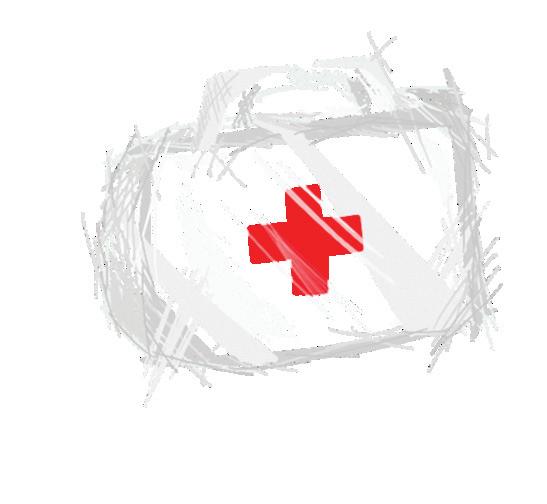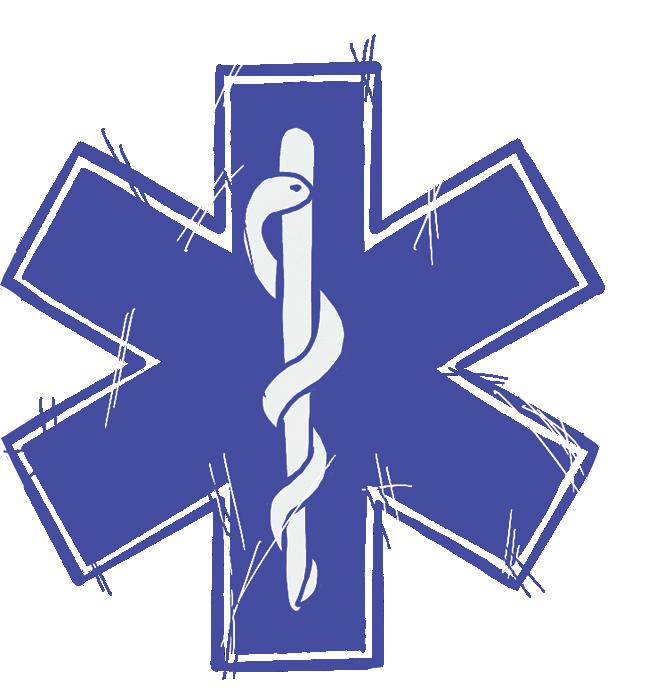
4 minute read
AFTER HOURS
art by NATE DONAKER
For the first three months of the 2022-23 school year, the EMTs stood in for athletic trainer, Justine Iongi, better known as Ms. E. In what ways have they impacted our student-athletes?
Navy blue shirts, high-speed electric scooters, bright red and white lettering spelling out “EMT.” From August to the end of October, these medical professionals were here whenever an athlete broke a finger on the football field, sprained an ankle during field hockey, or got hit by a water polo ball in the pool. Although the EMTs were only here at Paly for a short time, their impact was notable. But why were they here in the first place? Athletic director Jenny Crane explains the circumstances.
“They were hired because our athletic trainer was out on maternity leave and I tried to find a certified athletic trainer to replace her,” Crane said.
Mrs. E, Paly’s athletic trainer, went out on maternity leave this past year. Because of this, the school hired a group of Emergency Medical Technicians (EMTs) to supervise Paly athletes during games, practices, and events. They started their work after each school day ended, stayed for practices and games, and were on call for any emergency situation that occurred.
The athletic trainer provides comprehensive, in depth treatment, and Mrs. E, as well as Paly’s training room facility, is better equipped to deal with long-term injuries. The EMTs, on the other hand, focus solely on acute injuries and are primed for rapid emergency response.
EMT Jeff Long explains his job.
“We are like having 911 at your field,” Long said. “You’re going to have emergency first responders who are equipped to deal with any and every type of emergency at the sports events, we’re good at what we dow.”
Trainers like Mrs. E focus primarily on preventing and rehabilitating injuries, whereas EMTs provide emergency assistance in dire situations. These first responders are equipped to assist student-athletes with severe injuries in the short term, and a trainer would help with long-term recovery and prevent further accidents.
The fast, emergency treatment that the EMTs perform is vital, but so is helping athletes with long-term injuries. Because of this, Melissa Schulz, an athletic trainer at Agile Fitness, acted as a stand-in trainer. Shultz noted that her job is different than that of the EMTs.
“[Trainers] do a lot more tape injury prevention, assessing injuries, and then helping with their return to the sport after injury, as well as taking extra measures and screening on the field,” Schultz said. “EMTs have more of the emergency response, as far as more familiar with things that might be in an ambulance.”

Both the trainer and the EMTs have had vital roles regarding campus athletics. In Mrs. E’s absence, the EMTs helped many Paly student-athletes with their sports-related injuries. One such athlete is junior Ava Iribarren, who plays field hockey.
“During my field hockey game, I kept getting hit in my arm with the ball,” Iribarren said. “So much so that my arm continued to shake for almost an hour.
Then the EMTs came over and wrapped it. They assessed my injury and it really helped.”
To Iribarren, the EMTs were such a helpful resource that their absence will surely disrupt the flow of Paly’s athletic life.

“I feel like there’s gonna be a little upheaval when they first leave,” Ibibarren said.
Many athletes feel that when the EMTs leave, Paly’s athletic program will be hurt, because it will lose an extra layer of protection. Football player Jason Auzenne touches on how they have specifically helped him and his teammates.

“Thankfully there have never been any severe injuries on the football team this year that have required a lot of help from the EMTs, however in the case of any minor injuries they are always very quick to help,” Auzenne said. “They are always consistent in attending practices and games.”
The EMTs never intended to stay longer than a few months, but Paly students have quickly come to realize the advantage of having their assistance. Their unique familiarity with first-responder medical equipment provides security for athletes facing injuries that need quick treatment as opposed to the trainer’s more sustainable and long-term recovery methods.
“Our scope of practice is very large; we have more medical devices at our disposal,” Long said. “We can do more if somebody gets hurt badly. We provide services for not only the students but also the fans. And the parents and coaches have noticed what we do and think that that would be an awesome service.”
Despite the positive impact they have made on athletes in their few months on campus, extending their presence is not possible because of expense. Keeping the EMTs here would take a toll on the athletic budget.
“I think that there’s definitely a place for them in high school athletics,” Crane said. “It’s just a matter of the fact that we don’t have the funding for it.”
However, since Mrs. E’s maternity leave has ended, and she has returned to campus, the EMTs were let go. Now, Mrs. E will resume her normal duties as the athletic trainer, which mainly constitutes cupping to relieve pain, providing physical therapy exercises for athletes, and helping stretch injured limbs. While her job is not the same as that of a first responder, she provides essential care that many Paly athletes have missed, as well as being a vital part of the Paly athletic program.
Although the EMTs will no longer be helping out at Paly, their job helping young athletes and the general public alike, is certainly not over. EMT Tyler Sergeant provides insight on what they will do after their time at Paly.
“There are talks with other schools, but this company operates like many other EMS companies: we do private events as well,” Sergeant said. “It’s a mix of private events, so that’s what we’re primarily going to be doing afterward, just continuing with those events and or schools if they take us on.”
If Paly were to receive more athletic funding, the EMTs could be a source of auxiliary care for injured Paly athletes. Athletic Di rector Crane feels their support was valuable at Paly and would be happy to see them back, as an extra safety element in addition to the regular athletic trainer.
“I think it was great to have them on campus and to have them providing that kind of care,” Crane said. “There’s a place for both kinds of care. I think in high school athletics right athletic trainers are like longterm care, rest and recovery whereas the EMTs were trauma care if something happened in a game. Then they could give immediate care, emergency care.”
With Ms. E back at Paly, the EMTs are no longer needed to provide care for students at Paly. While students and staff are sad to see them gone, their contributions have been immense and they have had a lasting effect on many Paly athletes.










